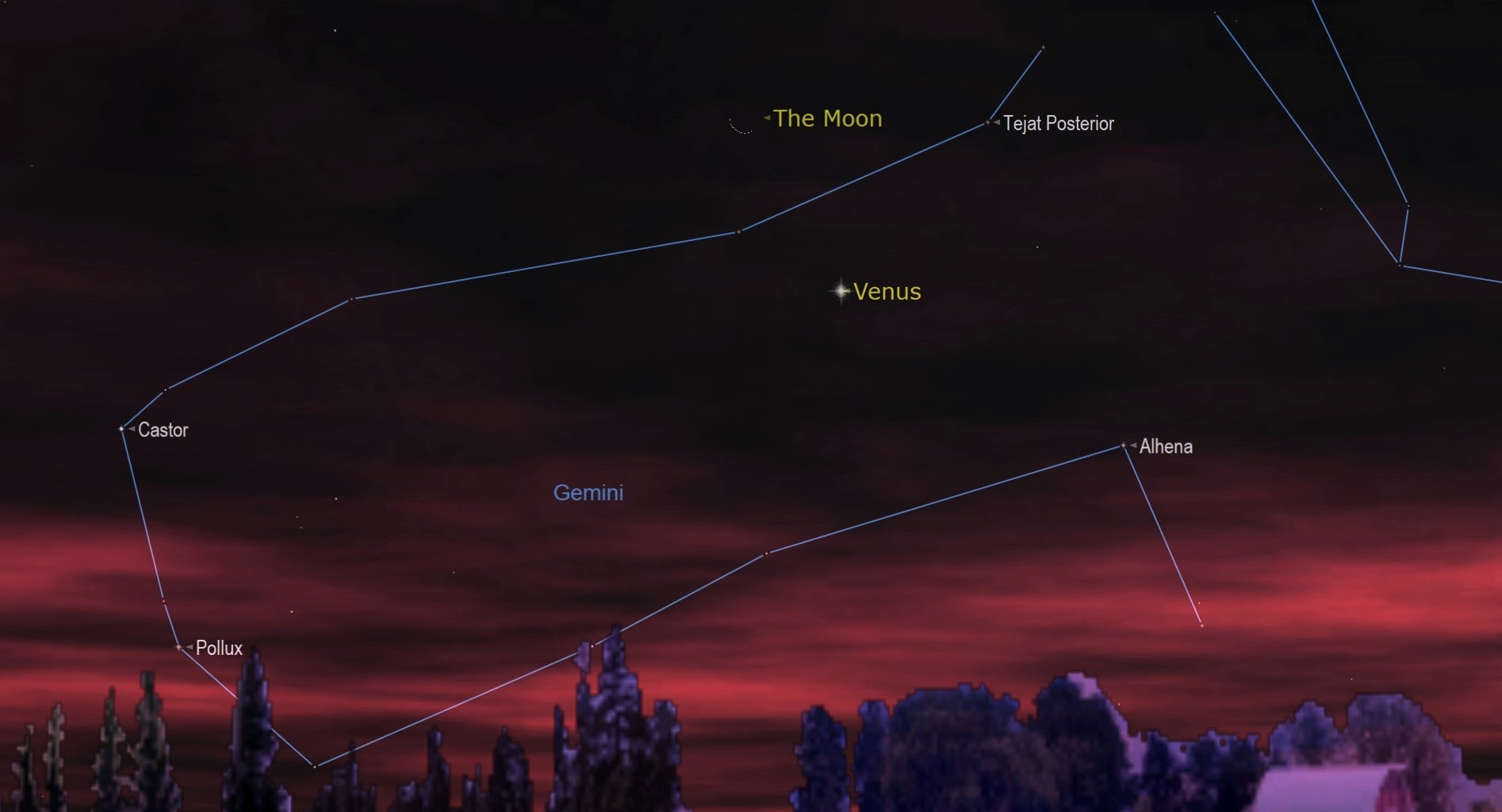Spot Venus shine under the thin crescent moon on Tuesday
The pair will be close enough to share the same field of view in a pair of binoculars.

Look to the east-northeastern sky before sunrise on Tuesday (July 26) to catch the thin crescent moon slither across the sky above Venus.
Venus will be shining at a bright magnitude of -3.9, just several finger-widths (or 4 degrees celestial south) to the lower right of the old moon, according to astronomer Chris Vaughan of Astrogeo.ca, who prepares Space.com's monthly Night Sky calendar in cooperation with Simulation Curriculum. (On the magnitude scale used by astronomers, lower numbers signify brighter objects.) The duo will appear close enough to share the view with a pair of binoculars.
Eagle-eyed skywatchers catching the pair shortly after they rise at around 4 a.m local time will also be able to see some of the stars of the Gemini constellation (Alhena, Pollux, Castor and Tejat Posterior) shine around them.
Related: The brightest planets in July's night sky: How to see them (and when)
The exact time of the event varies depending on your specific location, so you'll want to check out a skywatching app like SkySafari or software like Starry Night to check for times specific to you. Our picks for the best stargazing apps may help you with your planning.
On Thursday (July 28) the moon will reach its new moon phase at 1:55 p.m. EDT (1755 GMT). It will then conclude its monthly planetary "meet and greets" by approaching Mercury on Friday (July 29) shortly after sunset.

Looking for a telescope for the next stargazing event? We recommend the Celestron Astro Fi 102 as the top pick in our best beginner's telescope guide.
Another skywatching event to look out for this week is asteroid Juno appearing to reverse direction on Thursday. "Eastward prograde motion of the main belt asteroid designated (3) Juno through the background stars of western Pisces will slow to a stop," Vaughan wrote. Juno will then commence a westward retrograde loop that will last until late October.
Get the Space.com Newsletter
Breaking space news, the latest updates on rocket launches, skywatching events and more!
If you're looking for a telescope or binoculars to observe the moon, our guides for the best binoculars deals and the best telescope deals now can help. Our best cameras for astrophotography and best lenses for astrophotography can also help you prepare to capture the next skywatching sight on your own.
Fancy taking a more in-depth moonlit tour of our rocky companion? Our ultimate guide to observing the moon will help you plan your next skywatching venture whether it be exploring the lunar seas, mountainous terrain, or the many craters that blanket the landscape. You can also see where astronauts, rovers and landers have ventured with our Apollo landing sites observing guide.
Follow us on Twitter @Spacedotcom and Facebook.
Join our Space Forums to keep talking space on the latest missions, night sky and more! And if you have a news tip, correction or comment, let us know at: community@space.com.

Daisy Dobrijevic joined Space.com in February 2022 having previously worked for our sister publication All About Space magazine as a staff writer. Before joining us, Daisy completed an editorial internship with the BBC Sky at Night Magazine and worked at the National Space Centre in Leicester, U.K., where she enjoyed communicating space science to the public. In 2021, Daisy completed a PhD in plant physiology and also holds a Master's in Environmental Science, she is currently based in Nottingham, U.K. Daisy is passionate about all things space, with a penchant for solar activity and space weather. She has a strong interest in astrotourism and loves nothing more than a good northern lights chase!









